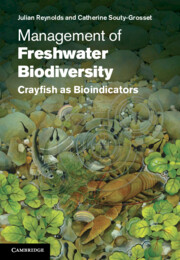Book contents
- Frontmatter
- Contents
- Preface
- Acknowledgements
- Introduction: Biodiversity in freshwater systems, and the key roles played by crayfish
- Part I The present situation of crayfish in world freshwater ecosystems
- Part II Applying science to conservation management
- A Protecting freshwater biodiversity through monitoring and conserving crayfish
- 6 Understanding and managing biodiversity using crayfish
- 7 Monitoring in conservation and management of indigenous crayfish populations
- B Management for conservation
- Part III Knowledge transfer for successful crayfish management
- References
- Glossary
- Index
- Scientific and common English names of well-studied crayfish featured in this book
- Common English and scientific names of well-studied crayfish featured in this book
- Plate section
7 - Monitoring in conservation and management of indigenous crayfish populations
from A - Protecting freshwater biodiversity through monitoring and conserving crayfish
Published online by Cambridge University Press: 05 December 2011
- Frontmatter
- Contents
- Preface
- Acknowledgements
- Introduction: Biodiversity in freshwater systems, and the key roles played by crayfish
- Part I The present situation of crayfish in world freshwater ecosystems
- Part II Applying science to conservation management
- A Protecting freshwater biodiversity through monitoring and conserving crayfish
- 6 Understanding and managing biodiversity using crayfish
- 7 Monitoring in conservation and management of indigenous crayfish populations
- B Management for conservation
- Part III Knowledge transfer for successful crayfish management
- References
- Glossary
- Index
- Scientific and common English names of well-studied crayfish featured in this book
- Common English and scientific names of well-studied crayfish featured in this book
- Plate section
Summary
Background to crayfish monitoring
Our knowledge of crayfish taxonomy and distribution is steadily improving; we now know that there are around 650 species of freshwater crayfish in many different habitats, although the ecological roles of most have not been studied or understood and only about 15 of these (less than 3%) are commercially exploited. The main commercial species are examined in Holdich (2002a) and all the European native species and their genetic variation are documented in Souty-Grosset et al. (2006). However, with such knowledge comes an awareness of possible differences in ecology, and indeed vulnerability, between related stocks.
Many crayfish species whose ecology has been studied are shown to play important roles in their ecosystems (Chapter 3). The community in which crayfish operate is modified and regulated by these keystone species, with a potential increase in biodiversity through food-web control. Management-led conservation needs the support of directed research. This should include evaluation of the current status and trends of freshwater biodiversity and of the drivers of change in fresh waters, including climate change and invasive species, and their impacts on freshwater biodiversity.
- Type
- Chapter
- Information
- Management of Freshwater BiodiversityCrayfish as Bioindicators, pp. 169 - 194Publisher: Cambridge University PressPrint publication year: 2011



